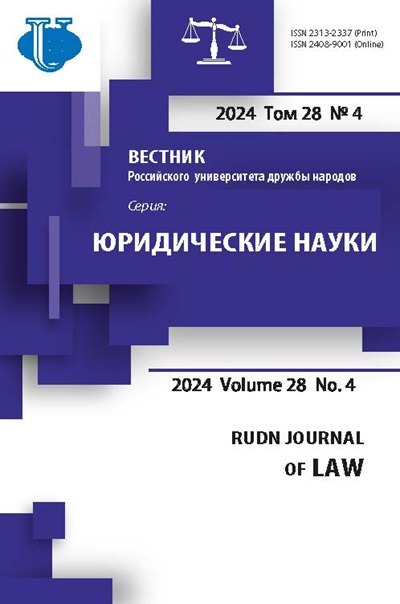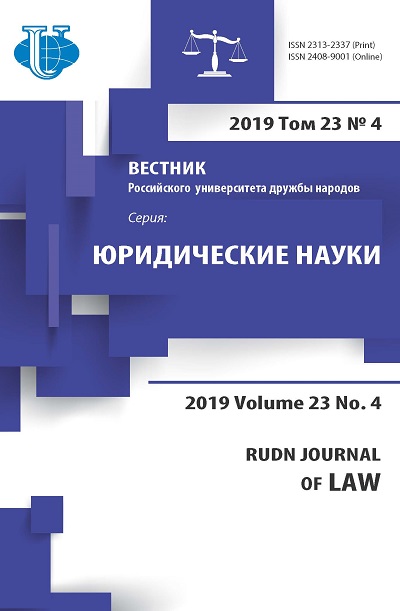ИНТЕГРАЦИЯ КАК ОБЪЕКТ ИССЛЕДОВАНИЯ ЮРИДИЧЕСКИХ НАУК
- Авторы: Рафалюк Е.Е.1
-
Учреждения:
- Секретариат Суда Евразийского экономического союза
- Выпуск: Том 23, № 4 (2019)
- Страницы: 490-509
- Раздел: ГОСУДАРСТВО И ПРАВО В СОВРЕМЕННОМ МИРЕ
- URL: https://journals.rudn.ru/law/article/view/22495
- DOI: https://doi.org/10.22363/2313-2337-2019-23-4-490-509
Цитировать
Полный текст
Аннотация
Решение как теоретических, так и практических задач, связанных с правовым обеспечением интеграционных процессов, обусловливает актуальность поиска соответствующих методологических подходов для исследования указанной проблематики. Обращение к проблемам методологии изучения юридической природы и права интеграционных межгосударственных объединений имеет важное значение, так как до сих пор отсутствует единообразие в теоретической трактовке и методах исследования правового обеспечения интеграции. Целью данной статьи является рассмотрение возможностей применения междисциплинарного, полидисциплинарного, трансдисциплинарного (системного) подходов к изучению отдельных проблем, связанных с правовым обеспечением интеграции. В основу анализа избранной проблематики автором положены положения отечественных и зарубежных научных работ, посвященных проблемам методологии юриспруденции. В результате проведенного исследования автор статьи приходит к выводу о том, что в условиях глобального мира сложные объекты действительности, к которым относится также интеграция, не могут быть познаваемы в рамках одной научной дисциплины, что является значимым аргументом в пользу обращения к междисциплинарной, полидисциплинарной и системной методологии. При выборе соответствующего методологического подхода к исследованию интеграции следует учитывать: существо и характеристику изучаемого объекта; задачи конкретного исследования; цель исследования. Не менее важным аспектом в изучении интеграции является обращение к аксиологическим аспектам интеграционных процессов, а следовательно, изучение различных аспектов региональной экономической интеграции, например, культурологического, социологического, психологического, направленных на исследование ценностей и целей интеграции, состояния общества, роли человека в интеграционном процессе.
Об авторах
Елена Евгеньевна Рафалюк
Секретариат Суда Евразийского экономического союза
Автор, ответственный за переписку.
Email: rafaliuk_e@mail.ru
кандидат юридических наук, советник экспертноаналитического отдела Секретариата Суда Евразийского экономического союза
220006, Минск, Республика Беларусь, ул. Кирова, д. 5Список литературы
- Bottomore, T.B. (1983) Introducción en Interdisciplinariedad y Ciencias Humanas, trad. de J.G. Péres Martín. Madrid, Tecnos UNESCO. (in Spanish)
- Calvo García, M. (1994) Los fundamentos del método jurídico: una revisión crítica. Madrid. Editorial: Tecnos. (in Spanish)
- Díez Sastre, S. (2018) La formación de conceptos en el derecho public. Un estudio de metodología académica: definición, funciones y criterios de formación de los conceptos jurídicos. Madrid. Editorial: Marcial Pons, Ediciones Jurídicas y Sociales. (in Spanish)
- Falcón y Tella, Mª J. (2014) La justicia como mérito. Monografías Jurídicas. Ediciones Jurídicas y Sociales. Madrid. Editorial: Marcial Pons. (in Spanish)
- Григорян К.Г. Комплексный подход к оценке состояния и перспектив развития региональных интеграционных объединений (на примере Ассоциации стран ЮгоВосточной Азии): автореф. дис. … канд. экон. наук. М.: ФГБОУ ВПО «Государственный университет управления». 2012. 22 с
- Ibánez Jiménez, J.W. (2011) Análisis económico del Derecho: método, investigación y práctica jurídica. Barcelona, Bosch: JMB. (in Spanish)
- Jiménez Piernas, C. (1995) El método del derecho internacional público: una aproximación sistémica y transdisciplinar. Editor: Universidad Carlos III de Madrid. Instituto de Estudios Internacionales y Europeos Francisco de Vitoria. Madrid, Tecnos. (in Spanish)
- Керимов Д.А. Методология права. Предмет, функции, проблемы философии права. 3-е изд., перераб. и доп. М.: Современный гуманитарный университет, 2003. 521 c
- Кимелев Ю.А. Методология социальных наук: (Современные дискуссии): Аналитический обзор / РАН. ИНИОН. Центр гуманит. науч.-информ. исслед. отд. философии; Отв. ред. Хлебников Г.В. М.: ИНИОН РАН, 2011. 94 c
- Кутыева Э.Р. Евразийство как явление культуры XX века. Историография и методология исследования. Автореф. дис. … канд. культурологии. СПб.: Издательство «ЛЕМА», 2005. 28 с
- Larenz, K. (1994) Metodología de la ciencia del derecho. Barcelona, Ariel Derecho. Editorial: Editorial Ariel. (in Spanish)
- Малахов В.П. Методологические и мировоззренческие проблемы современной юридической теории: монография / В.П. Малахов, Н.Д. Эриашвили. - 2-е изд. - М.: ЮНИТИ-ДАНА: Закон и право, 2018. 431 c
- Rodriguez Lozano, L.G., Zaragoza Huerta, J. (2012) La investigación del derecho y la ética. In: Metodología para investigaciones del alto impacto en las ciencias sociales. Madrid, Universidad Autónoma de Nueva León, Universidad Rey Juan Carlos. (in Spanish)
- Vallet de Goytisolo, J. (2004) Manuales de metodología jurídica. Madrid. Editorial: Fundación Cultural del Notariado. (in Spanish)
















